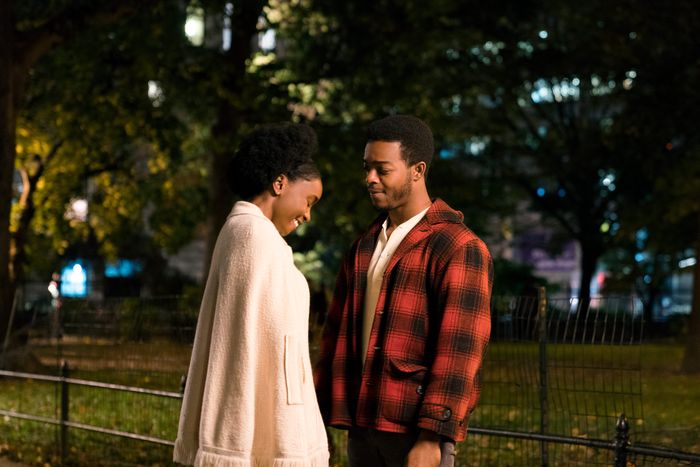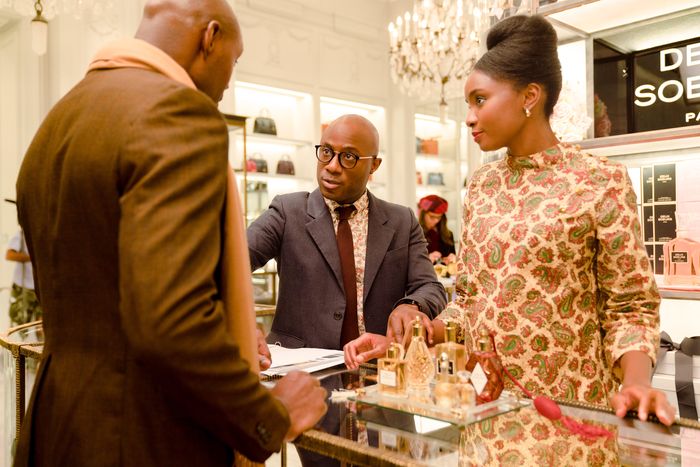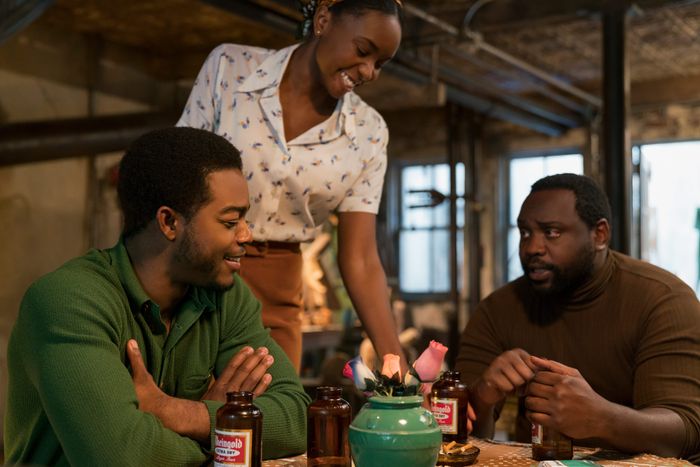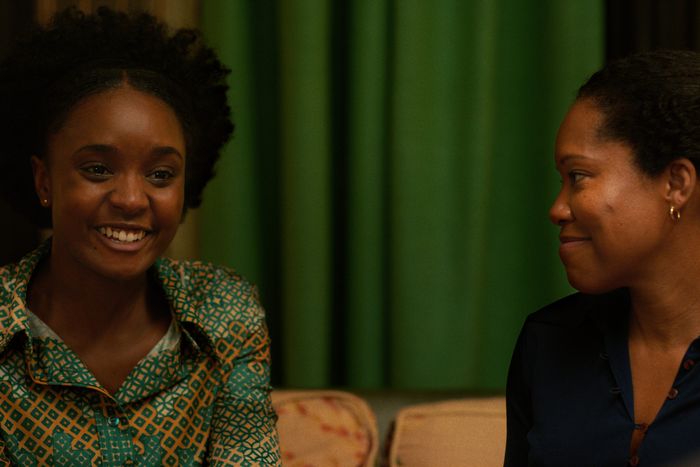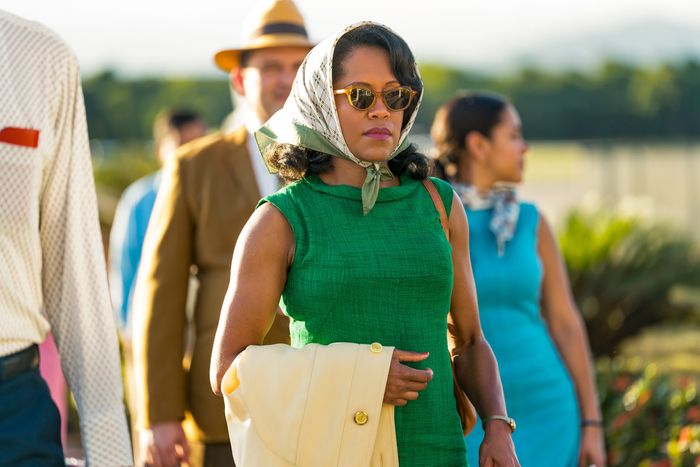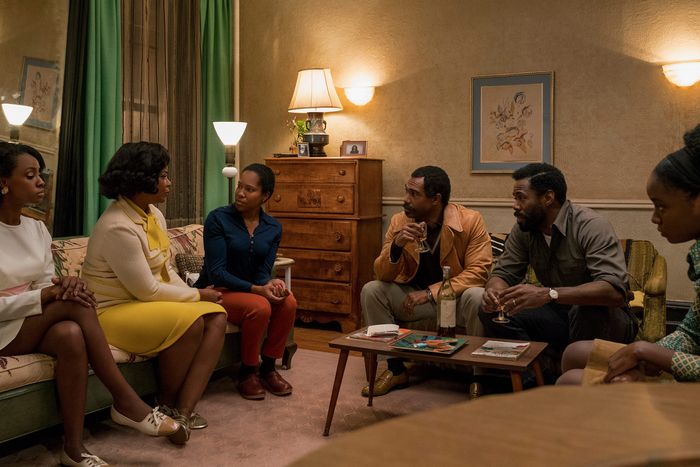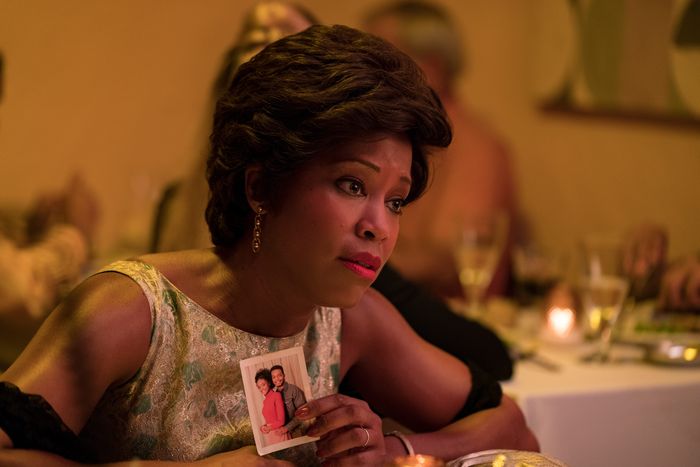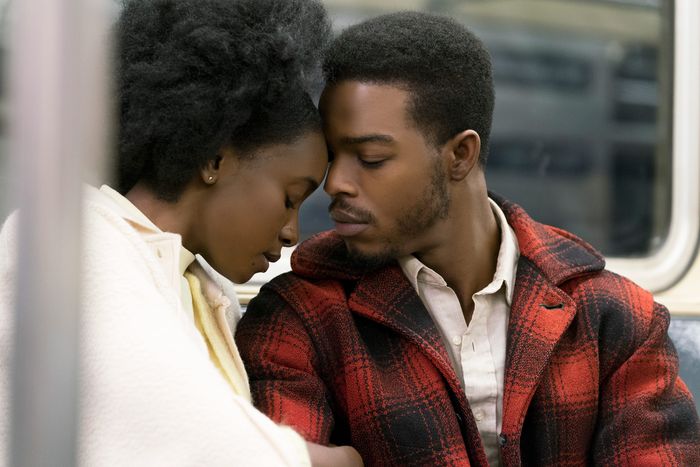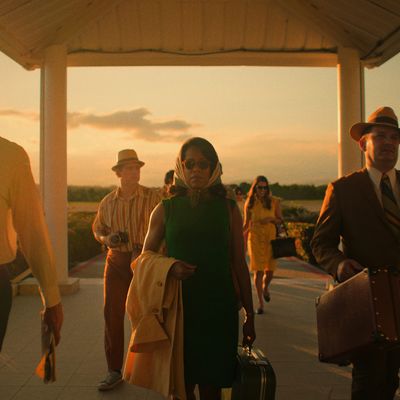
Writer-director Barry Jenkins’s deeply melancholic adaption of James Baldwin’s If Beale Street Could Talk tells the bittersweet story of Tish (KiKi Layne) and Fonny (Stephan James), a young Harlem couple that defies obstacles and remains in love despite being torn apart by a dysfunctional and racist justice system. It’s faithful to its source material in nearly every way, including its set design and costumes, which re-create the Harlem and New York City of the 1970s in rich detail and carefully coordinated earthy colors — yellows, browns, greens, and occasional blues.
“The book was our guide and we wanted to honor it. It was such a great responsibility to have. It was all in the book, and then translated into the script,” the film’s costume designer Caroline Eselin-Schaefer tells me about bringing Baldwin’s specifically articulated world to life. “The first thing that we did, Barry, myself, and Mark Friedberg, the production designer, was to look at photographic research of Harlem in the ’60s and ’70s. We looked at the works of Gordon Parks, Bruce Davidson, and Paul Fusco. We looked at many photographers from the time. We wanted to give it a sense of place.”
Eselin-Schaefer was careful not to make the costumes into a ’70s fashion show — instead, she melded the era with the ’60s (and sometimes even earlier eras), establishing both a living history in the film’s look and the limited resources of Tish’s family: parents Sharon (Regina King) and Joseph (Colman Domingo), and sister Ernestine (Teyonah Parris). “Fonny and the Rivers don’t come from money. They’re saving for [the baby] and for getting Fonny out of prison. They do the best with what they’ve got,” Eselin-Schaefer explains. “I like to think that Tish is wearing hand-me-downs from her sister. Fonny’s got a piece from his dad, things from Tish’s dad, things left over from the ’60s, things he’s found. And Tish wears what she works in. She repeats dresses because she doesn’t have the means to have an extensive wardrobe to wear something new all the time. They had some early dates with the yellow costumes, and then the blues and whites [she mixes up], making the best of what she had.”
Below, Eselin-Schaefer breaks down some of the film’s key looks, scenes, and colors.
Tish’s Cream Cape
Tish is an instant vision of romance and purity in a simple yet eye-catching cape she wears in rotation — once, unforgettably, under a red umbrella with Fonny. Eselin-Schaefer discovered the cape at the bottom of a cardboard box in a clothing recycler in New Jersey after a rather long search, either at Trans-Americas Trading Company or Udelco, Inc., where she also found a few cotton/natural fiber shirts (a hard get for the polyester-heavy era) worn by Tish and Sharon throughout.
“At the end of the day [in these places], you’re a dusty wretch. You find a million things. [The cape] just happened to be one of those treasures,” she says, recalling that she initially bought the cape for Ernestine. But when she shared it with Jenkins during a show-and-tell, he suggested that it looked more like Tish. “Funny how these things happen,” says Eselin-Schaefer. “It ended up being this piece that was so innocent and at the same time so mature. It’s beautiful, optimistic, and protective.”
Tish’s Paisley Dress
Another brilliantly repeated piece of costuming, Tish’s classically patterned, quarter-sleeved paisley dress appears most memorably behind a high-end department store’s perfume counter where she works. It has an effortless, sophisticated shift silhouette reminiscent of the ’60s and serves as one of Tish’s special work garments, which she pairs with an up-do. We also spot this garment on her as she meets with Fonny’s attorney — another occasion to make a strong impression.
The dress fits Tish so immaculately that you’d think it’s custom-made. But “it’s not manufactured,” says Eselin-Schaefer. “It’s from a wonderful place called Rue St. Denis Clothier in New York, in the East Village. I don’t think they’re [in business] any longer, from what I’ve seen. But they had wonderful, wonderful vintage pieces. And I got a lot of pieces from them for the movie. They were a great source for the industry and other vintage dealers. I really was grateful for them.”
All the Greens
It’s impossible to not notice the frequent blast of greens throughout Beale Street; it’s a color well-represented in Baldwin’s book, and one that Eselin-Schaefer wanted to honor as much as possible. The green shift dress Sharon Rivers wears during a Puerto Rico scene is just one instance where Eselin-Schaefer pulled a piece straight from the book. “I see green as life, as fertility,” says the designer.
Then there were visually harmonious occurrences that Eselin-Schaefer calls “happy accidents,” thanks to the close partnership between departments. For example, when Fonny is deep in conversation with his friend Daniel Carty (Brian Tyree Henry) over beers, the green of Fonny’s henley sweater serendipitously matches the vase on the table. “It was such a collaborative relationship between Mark Friedberg, set decorator Kris Moran, [and me]. There was always back and forth. We wanted to share our research and get better in our decisions. The second costume we worked on was Tish’s green-and-yellow garment, a patterned, long-sleeved shirt she wears in her apartment. We costumed that in the department, [matching it] with all the colors in the Rivers apartment.”
Another dramatic green piece: a corduroy coat Tish wears throughout. “It would have been a winter leftover; probably a hand-me-down for Tish,” Eselin-Schaefer says. “I found it at Right to the Moon Alice, about three hours away from New York. I will go on and on about Alice Lindholm’s, a wonderful costume house in Roscoe, New York. It’s the most beautiful costume house I’ve ever been to. It’s got the most wonderful collection on her farm, and it’s her business. We got lots of coats for Tish, and that was her heaviest coat. They don’t have much money. The green coat has served her well.”
Chaos in the Rivers’ Living Room
A domestic doomsday erupts when the Rivers family invites Fonny’s family, the Hunts, over to announce Tish’s pregnancy. This early sequence also allows the audience to take in an immediate bird’s-eye view of the two families juxtaposed with each other. Fonny’s mother, Mrs. Hunt (Aunjanue Ellis), arrives in a yellow skirt suit that deliberately renders her authoritative and uptight, whereas her daughters Adrienne (Ebony Obsidian) and Sheila (Dominique Thorne) don’t quite dress for their ages. “Baldwin wrote that Adrienne was in the cream dress with the pink-banded waist,” Eselin-Schaefer says. “That dress is very useful. This is where we get Adrienne in something that is too young for her, sort of girly. And Sheila is in something that is a little old for her. That’s the inspiration for these costumes. Sheila is so little, sitting like she’s not really comfortable in that. It’s a periwinkle blouse with a popped collar and a cream skirt. It’s wearing her; she’s not really wearing it.”
An instantaneous contrast to the Hunt sisters is Ernestine, who (like her mother) is in self-assured, comfortable trousers. It’s a plaid pair, worn with a soldier-green sweater, orange earrings, and an unexpected pair of slippers — a territorial touch. “When you read Ernestine on the page, she’s so sassy and funny, and also strong, and perceptive. She’s the best big sister you could ever want. I can’t take credit for her bedroom slippers — that was Barry’s request, and I think it was brilliant. She’s had her work clothes on, but she’s not taking off her slippers: ‘You’re coming in my home.’”
Fonny’s father, Frank (Michael Beach), arrives in one of the most striking pieces of costumes in the film: a camel-toned leather jacket of the era, which Eselin-Schaefer discovered in one of the abovementioned clothing recyclers in New Jersey. “It was a great find. Frank works in the Garment District. And if there’s anybody that will wear the latest and greatest in ’70s fashion, it would be Frank. He’s more up-to-date in his style and has that sort of swagger.”
Sharon’s Metallic Cocktail Dress
“It’s totally a [’60s-style] wiggle dress,” Eselin-Schaefer says about one of Sharon’s Puerto Rico dresses, a silvery, light-green floral-patterned garment that she puts on to ask for a favor from a powerful mafia-type figure. She both attempts to blend in and play up her femininity. “She knows she’s got to do this work. She’s going to this club to find this man, and she’s [almost] wearing a disguise. She’s pulled this out of the closet that she’s had for years. She was a singer in the early years, in the ’60s. She was younger then. But she pulls this out of her closet that she’s already got, and takes it with her to Puerto Rico.”
Fonny’s Red-and-Black Jacket
Fonny’s signature outerwear is almost synonymous with Beale Street’s widely seen stills. He wears it like a second skin. “That’s straight from Baldwin, absolutely,” Eselin-Schaefer says. “In the book, he wears it a lot; he wears it all the time. It’s still his security-blanket piece.”


